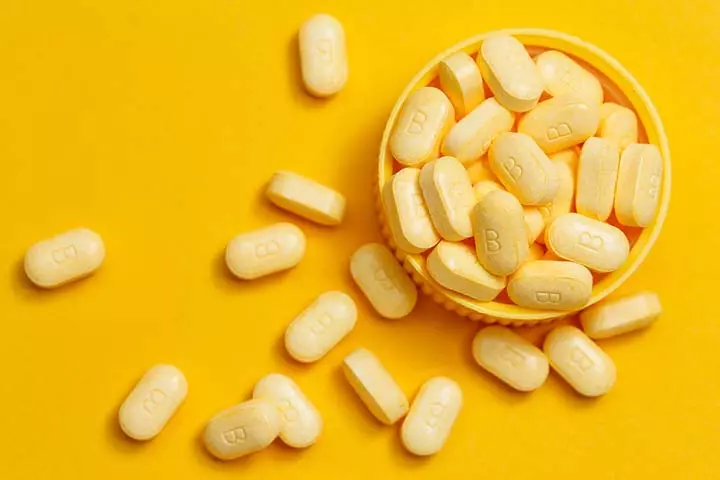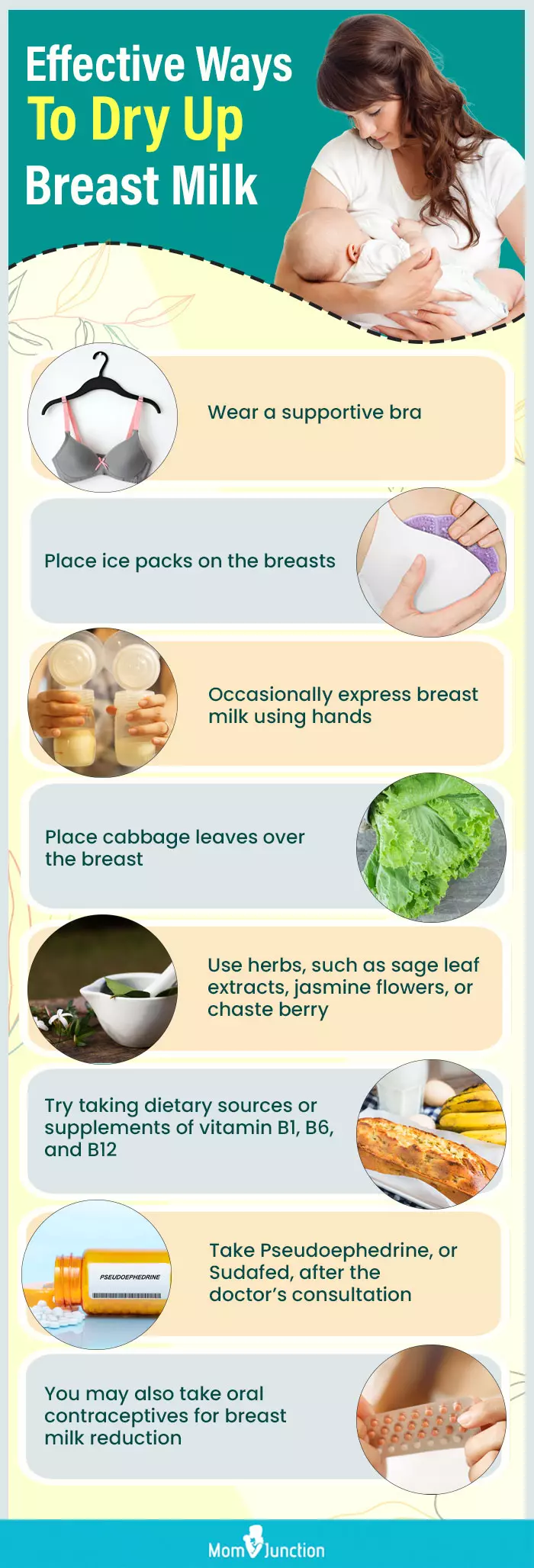
Most mothers may look for ways to dry up breast milk due to excess milk production and less need for breast milk after weaning the baby. Though breast milk can be fed to babies for up to two years, some mothers may consider stopping it before the breast milk is dried up due to personal or medical reasons. Early drying up is recommended if there are any health issues related to breastfeeding in the mother or baby.
Cessation of feeding or pumping can lead to breast engorgement and mastitisiAn infection of the breast tissue leading to swelling, redness, warmth, pain, and extreme sensitivity. in nursing moms. Hence, it is recommended to dry up breast milk as per a lactation consultant’s recommendations.
Read on to know the reasons to dry up breast milk, the ways to do it, and the risks involved in this process.
Key Pointers
- Seek advice from a lactation specialist before deciding on any method to dry up breast milk.
- Placing cold cabbage leaves or ice packs under the bra, a supportive bra, and sage tea are a few non-medical methods that help.
- Certain medications, such as pseudoephedrine and oral contraceptives, can also dry up breast milk.
Why Might A Mother Dry Up Breast Milk?
A breastfeeding mother may consider drying up breast milk due to the following reasons (1) (2).
- The mother does not wish to breastfeed due to personal reasons.
- The mother cannot breastfeed due to medical reasons.
- The breasts have not stopped milk production despite the infant being weaned.
- Oversupply of breast milk, also known as maternal hypergalactia or hyperlactation. This condition could lead to breast engorgement, clogged ductsiA condition where the milk duct gets blocked, leading to lumps, swelling, itching, and soreness. , and infections such as mastitis (3).

- The baby has abruptly stopped breastfeeding or cannot breastfeed for some other reasons.
Despite the reason to stop breastfeeding, it is best to consult a lactation expert to decide on a suitable approach to dry up breast milk.
How Long Does It Take For Breast Milk To Dry Up?
Some mothers may find themselves pondering the question, ‘How long does it take for milk to dry up?’ To answer that, it typically takes several weeks to months for milk to completely dry up. The time to dry up breast milk could depend on how long you have been breastfeeding, your current milk supply, and the method used for lactation suppression.
In some cases, even after cessation of milk supply, breasts may produce some milk occasionally. If your breast milk doesn’t dry up or suddenly secretes after a long gap, consult your healthcare provider to determine the possible causes.
Joining support groups or online forums may also be helpful for mothers who are weaning from breastfeeding. Sharing stories and tips with others offers both emotional support and practical guidance.
Methods To Dry Up Breast Milk
Non-medical methods
These methods may work for some mothers. Consult a lactation expert or doctor before choosing a method.
1. Cold turkey
You can observe a gradual cessation of breastfeeding to slowly reduce breast milk supply and eventually dry up breast milk. It’s essential to wean your baby off breastfeeding gradually. Sudden weaning may make breasts painfully engorged and may increase the risk of breast infection (mastitis) (4). You may prevent these effects by wearing a supportive bra, using ice packs, and expressing breast milk with hands occasionally (5) (1).
 Quick tip
Quick tip2. Cabbage

Research shows topical application of cabbage leaves on the breast may help reduce breast pain and relieve engorgement (6). However, its role in suppressing breast milk still needs more research. You can wear washed and dried, cold cabbage leaves inside the bra to prevent leaking breast milk and change them every two hours. Continue use until the breasts stop feeling too full (1).
3. Herbs
In traditional medicine, sage tea and sage leaf extracts are recommended herbs for breastfeeding women to reduce milk supply. The topical application of jasmine flowers and oral consumption of chasteberry reduce the prolactiniA hormone that manages breast tissue development and milk production in mammals. levels in the body and thus minimize milk supply (7).
4. Vitamin B

A few studies note that vitamin B1, B6, and B12 could suppress breast milk supply (8). For instance, vitamin B6 may block milk lactation by suppressing the prolactin levels in nursing mothers (9). However, clinical data supporting these effects are inconsistent and insufficient (10).
5. Binding
Breast binding is an age-old technique to cease breast milk production. However, this method doesn’t prove to be any more effective in drying up milk than other methods. Moreover, breast binding may increase breast pain due to breast engorgement.
Some other non-medical methods that may reduce breast milk secretion are decreasing breastfeeding or pumping, avoiding hot showers, and preventing massaging and stimulating the breasts.
Mary Barfield, a mom of two, says, “I had to stop my breastfeeding journey around the four-month mark because I had to go on a thyroid medication which is proven to pass into breastmilk. My pediatrician wasn’t comfortable with me breastfeeding my daughter with this medication in my breast milk. Things I used to dry up my breast milk are an electric pump, Burress pads, sudafed (a nasal decongestant), peppermint oil diluted with coconut oil, and cabbage leaves (ⅰ).”
6. Cold compress
A cold compress may also help dry up breast milk. First, heat up the breasts to get the milk flowing. A warm shower or heat pad can do this. Then, pump just enough to feel relief and make your breast less full. After you are done with pumping, turn to something cold, like a bag of frozen veggies or an ice pack. This coldness helps to bring down milk production. A balance of heat and cold is key. Make sure you’re comfortable all through, and monitor your milk production so you can tweak your routine if need be (11)
Medical methods
Using medicines to dry up breast milk may have side effects. If you breastfeed occasionally, then the baby could be affected, too. Consult a doctor before trying any medicine for drying breast milk.
6. Sudafed
Pseudoephedrine, sold as Sudafed, is an oral decongestant known to relieve nasal decongestion (12). A study showed that Sudafed suppresses prolactin secretion and reduces breast milk production (13) (14). However, its use during breastfeeding needs a doctor’s consultation.
7. Birth control pills

Consumption of combination oral contraceptives containing estrogen may reduce postpartum breast engorgement by reducing breast milk supply (15) (16). However, the use of contraceptives isn’t suggested for lactation suppression unless advised otherwise by a medical professional.
8. Other medications
Cabergoline is a medication that reduces prolactin levels in the body and reduces breast milk supply. It is commonly used for lactation suppression (5). However, this drug isn’t approved by the FDA. Your doctor may prescribe it under exceptional conditions as the drug’s efficacy and safety are not fully known.
 Caution
CautionIf you experience pain and discomfort due to breast engorgement, you may consider over-the-counter (OTC) anti-inflammatory and analgesic medications after doctor consultation.
Note: The use of bromocriptine for lactation suppression isn’t advisable as it raises the risk of health issues, such as maternal stroke and possibly psychosisiA mental disorder that may lead to losing contact with reality. .
 Things to know
Things to knowWhat Are The Possible Risks Of Drying Up Breast Milk?
Ceasing breast milk suddenly may lead to milk duct clogging. It may increase the risk of breast infection called mastitis, a painful condition that often resolves on its own, but if it doesn’t, it may turn severe.
Below are some symptoms that indicate breast infection.
- Painful hard lumps in the breast
- Warm breasts with red streaks
- Chills and fever
- Flu-like symptoms, such as sweating

You can express breast milk to relieve engorgement but keep it less frequent as it may re-stimulate breast milk supply.
It’s important to see a healthcare professional if any of the symptoms are severe, as acting early can help avoid complications.
Frequently Asked Questions
1. Can breast milk suddenly dry up?
No. Breast milk cannot dry up suddenly, but it can experience a sudden decrease in supply due to various factors, such as lack of sleep, stress, skipping breastfeeding, sickness, and not feeding on demand (17).
2. What does it mean for milk to dry up?
Drying up breast milk refers to gradually decreasing breastmilk supply through pharmaceutical approaches (such as drug treatments), or non-pharmaceutical approaches (such as wearing a tight bra, using jasmine flower and ice packs on breasts). This process of drying up breast milk is known as ‘lactation suppression’ (18).
3. How do I know if my breast milk is drying up?
In mothers, signs of decreasing milk supply include being unable to express milk and having soft breasts. You may also notice breastmilk drying up in babies, such as poor weight gain, low urine output, crying even after feeds, and a desire to be fed more frequently (18).
An oversupply of breast milk and the inability to breastfeed due to medical or personal reasons are some common reasons drying up breast milk becomes necessary for some mothers. Your current milk supply, how long you have been breastfeeding, and the method of lactation suppression are factors that determine how long it will take to dry up breast milk. Generally, gradually reducing your feeding frequency is the best way to dry up breast milk. However, you could try alternative methods after consulting a doctor.
Infographic: How To Dry Up Breast Milk After Weaning?
Even when your baby has stopped drinking breast milk, your breasts will continue to produce milk for some time. The following infographic discusses tips to dry up breast milk more quickly without experiencing breast engorgement, pain, or other side effects.

Illustration: Momjunction Design Team
Illustration: How To Dry Up Breastmilk And How Long Does It Take?

Image: Dall·E/MomJunction Design Team
Learn 7 easy methods to dry up your breast milk quickly and easily! Get the tips you need to stop lactating and get back to your normal routine.
Personal Experience: Source
MomJunction articles include first-hand experiences to provide you with better insights through real-life narratives. Here are the sources of personal accounts referenced in this article.
ⅰ. How to dry up your breast milk in 4 days;https://www.youtube.com/watch?v=q_kBh7JnQ7Y
References
1. Lactation suppression; Australian Breastfeeding Association
2. Suppressing Lactation And Weaning; The Royal Hospital For Women
3. Oversupply of breast milk and how to reduce it; NCT
4. Weaning: How To; La Leche League International
5. Lactation Suppression and Milk Production Following Perinatal Loss or Other Maternal Reasons; Saskatchewan Health Authority
6. Cabbage; Drugs and Lactation Database; NCBI
7. Anne Eglash; Treatment of Maternal Hypergalactia; NCBI
8. R G Marcus; Suppression of lactation with high doses of pyridoxine; NCBI
9. L B Greentree; Dangers of vitamin B6 in nursing mothers; NCBI
10. D. AlSaad et al.;Is pyridoxine effective and safe for post-partum lactation inhibition? A systematic review; Online Wiley
11. Lactation Suppression; CHOC
12. Pseudoephedrine; Medline Plus; US National Library Of Medicine
13. Khalidah Aljazaf et al.; Pseudoephedrine: effects on milk production in women and estimation of infant exposure via breastmilk; NCBI
14. Medications and breastfeeding; Government Of Western Australia
15. Contraceptives, Oral, Combined; Drugs and Lactation Database; NCBI
16. Medication Safety Tips for the Breastfeeding Mom; AAP
17. 4 factors that can decrease breast milk supply – and how to replenish it; The University of Texas Southwestern Medical Center
18. Oladapo OT and Fawole B; Treatments for suppression of lactation; Cochrane
19. Management of breast conditions and other breastfeeding difficulties; NCBI
Community Experiences
Join the conversation and become a part of our nurturing community! Share your stories, experiences, and insights to connect with fellow parents.
Read full bio of Mary Miller
Read full bio of Swati Patwal
Read full bio of Rohit Garoo
Read full bio of Anindita Ghatak



















